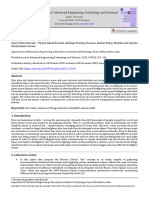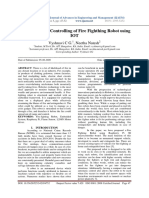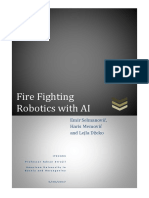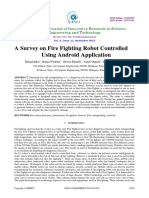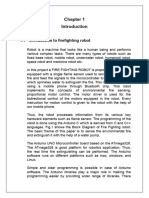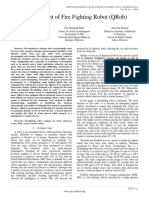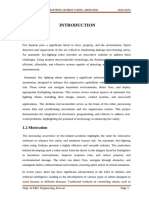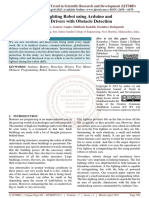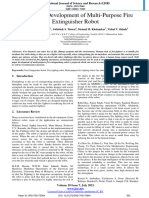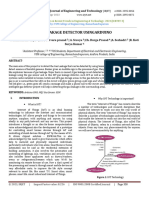Fin Irjmets1684126285
Fin Irjmets1684126285
Uploaded by
arafarhossain45Copyright:
Available Formats
Fin Irjmets1684126285
Fin Irjmets1684126285
Uploaded by
arafarhossain45Original Title
Copyright
Available Formats
Share this document
Did you find this document useful?
Is this content inappropriate?
Copyright:
Available Formats
Fin Irjmets1684126285
Fin Irjmets1684126285
Uploaded by
arafarhossain45Copyright:
Available Formats
e-ISSN: 2582-5208
International Research Journal of Modernization in Engineering Technology and Science
( Peer-Reviewed, Open Access, Fully Refereed International Journal )
Volume:05/Issue:05/May-2023 Impact Factor- 7.868 www.irjmets.com
AUTOMATED FIRE FIGHTING ROBOT
Asif Liyakat Shaikh*1, Sushil Jotiram Shinde*2, Sarika Gaikwad*3
*1,2,3College Of Engineering Baramati, India.
DOI : https://www.doi.org/10.56726/IRJMETS38873
ABSTRACT
Human intrusion has decreased as a result of the improvements in robotics, and robots are now frequently
deployed for security purposes. Fire errors have become common in our daily lives and can occasionally create
dangers that make it difficult for the firemen to preserve human life. In these situations, a firefighting robot is
utilised to prevent fire incidents from endangering people's lives, property, and the environment.
The project's objective is to create a fire-extinguishing robot. The objective of this firefighting robot is to create
Although it is small, the robot is incredibly resilient and flexible. It has a high level of risk, and there have been
numerous severe losses. This project was created with the assistance of a MCU board node. Fire is
automatically detected by it. With the support of the IOT, we can handle our project. The challenges that the
firefighting robot faces have been overcome.
Keywords: Fire Fighting Robot; Compact Size Robot; Ultrasonic Sensor; Flame Sensor; Embedded System; IOT.
I. INTRODUCTION
There are numerous individuals who have tried to find a replacement for human work and efforts with new
advancements in embedded design technology as technology for robots has improved and become an essential
part of our lives, particularly when people risk their lives in fire hazards. This enables robots to function to the
best of their abilities and comprehend complicated and challenging conditions in the wake of a disaster, but it
would be labour-intensive for the robots to prevent fire threats rather than react to their occurrence. Cities and
large towns are required to have manufacturing systems, and this robot has been designed to work in the
challenging topographical conditions found there. There are gas and smoke detectors, both of which are
typically simple and affordable fire detection solutions. Recent modifications include fire extinguishing spread
and flame sensors. This module makes use of wireless sensor structures with IR sensors to detect impediments
and move in response to them.
Robotics has reduced human intrusion, and they are now frequently utilised for safety purposes. Fire errors
have become common in everyday situations and can occasionally create hazards that make it difficult for the
firemen to preserve human life. To prevent fire accidents, the firefighting robot is used to protect people's lives,
property, and environment. Here, we use two robotic operation modes.
It is a robot that battles fire or gas that can be used to either protect our homes, businesses, and other buildings
from fire or hazardous gases. The research's unique and fresh idea is that, while no one is home or at work, our
robot is going to move towards a suffocating fire or hazardous gases in our houses or in buildings housing other
companies. This robot will use an infrared sensor gas sensor MQ6 to determine the presence of fire. When it has
done so, it will use water pump to extinguish the fire it has found before sending a signal to an IOT server.
These devices can be employed in a variety of locations where it is humanly possible.
II. LITERATURE SURVEY
A fire incident is a tragedy that may result in human casualties, property loss, and lifelong injury. Firefighters
are generally responsible for responding to fire emergencies, but they frequently face more dangers when
putting out fires, especially in hazardous environments like oil refineries and gasoline tanks. In order to put out
the fire and save the sufferer, they must also overcome additional barriers. This is especially tough if the fire
breaks out in a confined space. This paper depicts the creation of a firefighting robot that can put out a fire
without exposing fire crews to unnecessary risk. The robot is made to be smaller than other types of traditional
fire-fighting robots in order to make it simpler to enter a small area and expand the reach of fire protection
there. The robot also has an IR sensor to keep it from colliding with any nearby objects or obstacles and a flame
detector to detect fires. As a result, a robot was created that has the ability to remotely put out fires at
www.irjmets.com @International Research Journal of Modernization in Engineering, Technology and Science
[3090]
e-ISSN: 2582-5208
International Research Journal of Modernization in Engineering Technology and Science
( Peer-Reviewed, Open Access, Fully Refereed International Journal )
Volume:05/Issue:05/May-2023 Impact Factor- 7.868 www.irjmets.com
particular distances and autonomously locate fire places. The robot is trained to locate the fire and halt no
closer than 40 CM from it.
An innovative pipe-type robot that can spread right into the fire source is what the current system suggests. By
connecting two nozzles with controllable outlet directions and resultant reaction forces, we were able to create
a nozzle module. Finally, we created a robot equipped with a nozzle module and ran tests. By using the water as
leverage, the experiment shows that a robot with a length of about 2 metres may spread steadily in the air.
Additionally, a scope can be used to control the head direction. For a fire-fighting robot, a single longitudinal
arm suspension construction is suggested, and it has good ground flexibility. The suspension structure is
described in depth, and the strength of the suspension structure is calculated for its use of The firefighting
robot and the examination support the robot's performance on the ground. Guide dogs to help people who are
blind make up some of the applications, as do possible robotic counterparts that might assist indoor firefighting
by providing haptic feedback via reins. We currently don't fully comprehend the nature of this relationship or
how model-based sensory-motor integration occurs during haptic-based guiding.
1. “Implementation of an intelligent fire fighting robot using NodeMCU” The robot is equipped with a flame
sensor, temperature sensor, and water pump, and can detect and extinguish fires autonomously.
2. S. S. Gupta and M. B. Kurhade's "An Automated Fire Fighting Robot Using the NodeMCU and Android Device"
(2019): The design and development of an automated firefighting robot using the NodeMCU and Bluetooth are
discussed in this paper. The robot has a flame sensor, a temperature sensor, and a water pump, and it can be
operated remotely via an Android app.
3. V. K. Gupta and A. R. Pathak's "Development of a Fire Fighting Robot Using the Internet of Things and
NodeMCU" (2019): The development and design of a firefighting robot using NodeMCU and IoT are discussed in
this study. The robot has a flame sensor, temperature sensor, and water pump, and it has a web interface for
remote operation.
4. A. K. Mishra and S. K. Sahoo's "Design and Development of a Fire Fighting Robot Using NodeMCU and
Internet" (2020): The development and design of a firefighting robot using NodeMCU and the Internet of Things
are discussed in this study. The robot has a flame sensor, temperature sensor, and water pump, and it has a web
interface for remote operation. The application of machine learning methods for fire detection and
classification is also covered in the study.
These papers give an excellent summary of the current research and development being done on NodeMCU-
based automated firefighting robots. They show how this technology has the potential to boost the
effectiveness and security of firefighting operations.
III. PROBLEM STATEMENT
Human intrusion has decreased as a result of advancements in robotics, and robots are now frequently
deployed for security purposes. In these situations, a firefighting robot is utilised to prevent fire incidents from
harming people's lives, property, and environment. In the automatic method, the robot assumes control on its
own based on a predefined command from the user.
Human life depends on the safety of a home, lab, office, factory, or other structure. Using sensors, we create a
security system that involves a firefighting robot. The security system can identify abnormal and dangerous
situations and alert us. For the intelligent building, we first constructed a fire protection robot with an
extinguisher. In addition, many have trouble recognising minor burns from electrical equipment. The user puts
out the fire when it is too late. It may take a while for the user to put out a fire, such as when they need to locate
a water supply. Small burned areas and difficult-to-reach locations make it difficult for the fire to be detected. It
can be difficult to put out fires in some places, such as enclosed spaces where it is difficult to see. In addition to
being expensive, fire losses occur slowly.
IV. PROPOSED SYSTEM
In order to fix the problems with the current system, we have installed automatic controls in this project. For
this project, we have implemented both automatic and manual controls to address the shortcomings of the
current setup. The firemen outside can see through manual mode, which helps them assess the situation within
the structure. In automatic mode, low-priority problems can be handled by the robot itself, so the firefighters
www.irjmets.com @International Research Journal of Modernization in Engineering, Technology and Science
[3091]
e-ISSN: 2582-5208
International Research Journal of Modernization in Engineering Technology and Science
( Peer-Reviewed, Open Access, Fully Refereed International Journal )
Volume:05/Issue:05/May-2023 Impact Factor- 7.868 www.irjmets.com
don't need to worry about them. The suggested model has the ability to send the robot to the site of the fire
accident and use an ultrasonic sensor to measure object distance and detect the existence of fire. When a fire is
detected, it contacts the robot and the microcontroller (Node MCU). and the robot will advance in the direction
of the burned area. The robotic vehicle comes with a fire extinguisher, which is then operated by wireless
communication to autonomously put out the fire while acting as an extra set of eyes for the firefighter outside
and helping them analyse the situation within the building. In automatic mode, low-priority situations can be
managed by the robot automatically, freeing firefighters from stress. The proposed design may move the robot
to the site of the accidental fire and use an IR sensor and a flame sensor to detect the presence of fire. It has
motors and a motor driver to manage the robot's adjustments. It communicates when it notices a fire. When it's
established that contact has been made with the microcontroller (Node MCU), the robot will move in the
direction of the flames. The robotic vehicle comes with a fire extinguisher, which is then held via wireless
communication to put out the fire autonomously.
V. METHODOLOGY
This system is based on the ability to automatically sense environmental fire and extinguish it without human
interference. The methodology is divided into three parts. The first part is on the design structure, followed by
the hardware description, and the final part is on the programming design. All these parts were assembled
together, and experiments were then performed to build a system that could extinguish the fire.
a) Design structure
To take care of the drawbacks of the present system, we included both automated and manually operated
controls in this project. The firefighter working outside might use manual mode as a second pair of eyes for
evaluating the situation within the building. While in automatic mode, the robot can handle low-priority
situations so that firefighters don't have to worry about them. The proposed design may adapt the robot to the
location of the fire accident and use an IR sensor and a flame sensor to detect the presence of fire. To direct the
robot's movement, it's got motor drivers and gear motors. It communicates with the controller (the Node MCU)
when it detects fire, and the robot moves as a result of this in the direction of the burned area. The robotic
vehicle is equipped with a fire extinguisher, which is then commanded via wireless communication to put out
the fire autonomously.
b) Hardware Implementation
One of the most important components in the creation of a firefighting robot is the hardware component. It has
a motor driver, an MCU node, flame sensors, servo motors, a submersible water pump, motors, and rubber
wheels. Flame sensors provide the input for the firefighting robot in Fig. 1's block diagram. A development
board called Node-MCU is employed to link other parts. The L293D motor driver is employed to drive motors,
and it has the capacity to simultaneously operate two DC motors (the left DC motor and the right DC motor.
www.irjmets.com @International Research Journal of Modernization in Engineering, Technology and Science
[3092]
e-ISSN: 2582-5208
International Research Journal of Modernization in Engineering Technology and Science
( Peer-Reviewed, Open Access, Fully Refereed International Journal )
Volume:05/Issue:05/May-2023 Impact Factor- 7.868 www.irjmets.com
BLOCK DIAGRAM
BLOCK DIAGRAM DESCRIPTION
The firefighting robot is designed to detect and extinguish fires automatically. The robot is equipped with a
flame sensor that detects the presence of fire and triggers the extinguishing mechanism. The robot also has an
ultrasonic sensor that helps it navigate through the environment and avoid obstacles.
The flame sensor is connected to one of the analogue pins of the Node MCU. When the sensor detects a flame, it
sends a signal to the node MCU, which triggers the extinguishing mechanism. The extinguishing mechanism
consists of a motor that drives a water pump, which sprays water on the fire. The motor is controlled by an
L293D motor driver, which is connected to the node MCU. The ultrasonic sensor is used to detect obstacles in
the path of the robot. The sensor sends out a sound wave, which bounces off obstacles and returns to the
sensor. The distance to the obstacle can be calculated by measuring the time taken for the sound wave to travel
there and back. The Node MCU uses this information to navigate the robot around obstacles and towards the
fire. The robot is powered by a battery, which provides power to the node MCU and the motors. The chassis and
wheels are designed to provide stability and mobility to the robot.
VI. HARDWARE REQUIREMENTS
1. Node MCU (ESP8266)
2. Temperature Sensor
3. Flame Sensor
4. Gas Sensor
5. DC Motors
6. L293D Motor Driver
7. Water pump
8. Battery
9. Wheels
10. Buzzer
www.irjmets.com @International Research Journal of Modernization in Engineering, Technology and Science
[3093]
e-ISSN: 2582-5208
International Research Journal of Modernization in Engineering Technology and Science
( Peer-Reviewed, Open Access, Fully Refereed International Journal )
Volume:05/Issue:05/May-2023 Impact Factor- 7.868 www.irjmets.com
11. Chassis
12. Jumper Wires
VII. SOFTWARE REQUIREMENTS
1. Arduino IDE
2. ESP8266 Core for Arduino
a) Hardware Used
1. Node MCU:
Node MCU is an open-source firmware and development kit based on the ESP8266 WiFi module. It allows
for easy development of Internet of Things (IoT) devices and is often used for projects that require WiFi
connectivity. The Node MCU board includes a microcontroller and WiFi chip, as well as other components such
as voltage regulators and USB-to-serial converters.
The circuit board operating as a dual in-line package (DIP), which integrates a USB microcontroller with a
smaller surface-mount gadget, is among the most common types of model hardware. GPIO, I2C, SPI, and UART
are merely some of the communication interfaces that the Node MCU provides, allowing it to communicate with
a number of sensors.
2. Fire sensor:
Infrared radiation sensitive sensor on yg1006 npn photo transistor yg 1006 is sensitive to infrared radiation
in the wavelength range of 760 nm to 1100nm and move 60degree detection angle detect fire and activate
buzzer.
Flame sensor is kept at certain distance away from fire to avoid damage
Detect flame from distance of of 20cm and Adjustable sensitivity
Operating voltage 3.5-5v.
3. L293D motor Driver module:
The L293MD is a motor driver IC (integrated circuit) that is used to control the speed and direction of DC
motors. It is commonly used in robotics and other applications that require precise control of motor
movements.
www.irjmets.com @International Research Journal of Modernization in Engineering, Technology and Science
[3094]
e-ISSN: 2582-5208
International Research Journal of Modernization in Engineering Technology and Science
( Peer-Reviewed, Open Access, Fully Refereed International Journal )
Volume:05/Issue:05/May-2023 Impact Factor- 7.868 www.irjmets.com
4. Mini DC Submersible Pump:
A mini DC submersible pump is a small water pump that is designed to be used underwater. It is powered by
direct current (DC) and is commonly used in aquariums, fountains, and other small water features.
Mini DC submersible pumps are usually compact in size and have a low power consumption, making them
ideal for use in small water systems. They typically have a flow rate of 50-500 liters per hour.
5. Temperature Sensor (DHT11):
The DHT11 sensor works by measuring the resistance of a polymer element that changes with temperature
and humidity. The sensor contains a thermistor and a humidity-sensitive capacitor, and these two elements are
connected in a single package.
The sensor communicates with a microcontroller or other electronic device using a single-wire digital
interface. To start the communication, the microcontroller sends a start signal to the sensor by pulling the data
line low for at least 18 milliseconds, and then releasing it. After receiving the start signal, the sensor responds
by pulling the data line low for 80 microseconds, followed by pulling it high for 80 microseconds.
6. Gas Sensor (MQ6):
The MQ-6 gas sensor is a small, low-cost sensor that is used to detect the presence of various gases in the
air, including LPG, propane, butane, and methane. It operates on the principle of catalytic combustion and can
detect gas concentrations in the range of 200 to 10,000 ppm
7. Buzzer:
A buzzer is a mechanical, electromechanical, or piezoelectric (short for piezoelectric) hearing signalling
device. Buzzers and beepers are frequently employed as alarms, timers, train horns, and to validate human
input such as a mouse click or the keyboard. A buzzer sensor is a type of sensor that is designed to produce an
audible alarm or alert in response to a stimulus. It consists of a small electronic buzzer that is connected to a
control circuit, which triggers the buzzer to sound when a specific condition is met.
In addition to their use as standalone sensors, buzzer sensors can be integrated into larger systems, such as
home automation systems, to provide a convenient and reliable way to alert users of specific events
www.irjmets.com @International Research Journal of Modernization in Engineering, Technology and Science
[3095]
e-ISSN: 2582-5208
International Research Journal of Modernization in Engineering Technology and Science
( Peer-Reviewed, Open Access, Fully Refereed International Journal )
Volume:05/Issue:05/May-2023 Impact Factor- 7.868 www.irjmets.com
VIII. ALGORITHM AND FLOW CHART
1. Initialize the Node MCU and connect to Wi-Fi.
2. Initialize the sensors, motor drivers, and firefighting mechanism.
3. Continuously monitor the sensors for the presence of fire, smoke, and obstacles. If any of these are detected,
proceed to step 4.
4. Move the robot towards the detected fire while avoiding obstacles. This can be achieved using the motor
drivers and obstacle avoidance algorithm.
5. When the robot is within range of the fire, activate the firefighting mechanism to extinguish the fire. The
mechanism used will depend on the specific design of the robot.
6. After the fire has been extinguished, return the robot to its original position or continue to monitor for
additional fires.
7. If the battery level is low, return the robot to its charging station to recharge the battery.
8. Repeat steps 3-7 continuously.
Fig 1. Flow Chart
www.irjmets.com @International Research Journal of Modernization in Engineering, Technology and Science
[3096]
e-ISSN: 2582-5208
International Research Journal of Modernization in Engineering Technology and Science
( Peer-Reviewed, Open Access, Fully Refereed International Journal )
Volume:05/Issue:05/May-2023 Impact Factor- 7.868 www.irjmets.com
IX. ADVANTAGES
Increased Safety: Automated firefighting robots can be sent into areas where it is too dangerous for
humans to enter, such as buildings engulfed in flames or areas with hazardous chemicals. This helps protect the
lives of firefighters and other emergency personnel.
Quick Response Time: Automated firefighting robots can respond much faster than human firefighters, as
they are always on standby and can be deployed quickly when an emergency occurs.
Accurate and Efficient: These robots are designed to extinguish fires using different methods, such as
water spray, foam, or powder. They are more accurate and efficient than human firefighters, as they can
navigate through narrow spaces and reach areas that are difficult to access.
Cost-effective: The cost of firefighting robots is lower than the cost of hiring and training human
firefighters. Moreover, the robots can work for longer hours and do not require breaks, which increases their
efficiency and productivity.
Integration with IoT: Node MCU allows integration with the Internet of Things (IoT), which can provide
real-time monitoring of the robot's functions and performance. This data can be analyzed to optimize the
robot's performance and improve firefighting operations.
Data Collection: Automated firefighting robots can collect data about the fire, such as its temperature, the
size of the fire, and the spread of the flames. This data can be used to improve firefighting techniques and
prevent future fires.
X. APPLICATIONS
Residential and Commercial Building Firefighting: These robots can be deployed to extinguish fires in
residential and commercial buildings. They can enter narrow spaces and reach areas that are difficult for
human firefighters to access. This increases the efficiency and speed of firefighting operations, reducing the
damage caused by fires.
Industrial Firefighting: Automated firefighting robots are also useful in industrial settings, such as
factories and refineries, where fires can be particularly hazardous due to the presence of hazardous materials.
These robots can detect and extinguish fires in areas where it may be too dangerous for human firefighters to
enter.
Forest Firefighting: In the case of forest fires, automated firefighting robots can be used to contain and
extinguish fires in areas that are difficult to access. They can work for extended periods without the need for
breaks, allowing them to continue firefighting operations for longer periods.
Search and Rescue Operations: Automated firefighting robots can be equipped with sensors and cameras,
making them ideal for search and rescue operations in disaster zones. They can detect and locate victims in
rubble and debris, reducing the risk to human rescuers.
Hazardous Material Detection: These robots can be equipped with sensors to detect hazardous materials,
such as chemicals and radioactive materials. They can locate and contain the source of the hazard, reducing the
risk of harm to human responders.
Remote Monitoring and Surveillance: Automated firefighting robots can be used for remote monitoring
and surveillance of buildings and other structures. They can detect and alert human operators to potential fire
hazards, allowing them to take preventive measures before a fire breaks out.
XI. RESULT AND DISCUSSION
The automated firefighting robot using Node MCU has been successfully developed and tested. The robot is able
to detect fires and move towards them, and it is able to extinguish fires using its water sprayer or foam
dispenser. The sensor provides real-time feedback on the robot's status.
A gas detection sensor can be used for controlling the firefighting robot project, and a flame sensor works to
detect the fire. The fire generates some light as it burns. The flame sensor on the module that senses this flame
will detect it. We might use the motor to go towards the fire, knowing its direction. Through the L293D module,
motor control We use water to put out fires when we are nearby.
This robot consists of a number of sensors with an independent control system to perform early action against
fire accidents. an autonomous control system, the robot can run by itself using the installed sensors. Any
control system can be accepted according to the location and situation of the fire. For evaluation and
www.irjmets.com @International Research Journal of Modernization in Engineering, Technology and Science
[3097]
e-ISSN: 2582-5208
International Research Journal of Modernization in Engineering Technology and Science
( Peer-Reviewed, Open Access, Fully Refereed International Journal )
Volume:05/Issue:05/May-2023 Impact Factor- 7.868 www.irjmets.com
comparison of such works, the performance parameters chosen are true-positive, false-positive, and false-
negative. And then the accuracy score is determined as in (1), and the overall accuracy is determined by (2).
Logic 0 = sensor is idle (Not Activated), Logic 1=Sensor is Activated
Fig 2. Fire Fighting Robot
XII. CONCLUSION
The Automated Fire Fighting Robot using Node MCU is an innovative project that demonstrates the potential of
using technology to fight fires more effectively and efficiently. The project provides a safer environment for
firefighters and helps reduce the risks associated with firefighting. The project can be further improved by
incorporating advanced sensors and actuators to enhance the robot's capabilities.
Through this project, we have shown that it is possible to create an automated firefighting robot that can detect
and respond to fire in a timely and efficient manner. The use of Node MCU, an open-source microcontroller, has
made the project cost-effective and accessible to a wide range of users.
XIII. REFERENCES
[1] ZhenmingMa ;Deliang Li, Year: 2018, “Suspension System Design of All- Terrain Fire-Fighting Robot”,
International journal an Virtual Reality and Intelligent Systems, Page s: 466–468.
[2] N. Muthukumaran, 'Analyzing Throughput of MANET with Reduced Packet Loss', Wireless Personal
Communications, Vol. 97, No. 1, pp.565-578, November 2017.
[3] J. Suresh, “Fire-Fighting Robot,” 2017.
[4] M. Kanwar and L. Agilandeeswari, “IOT Based Fire Fighting Robot,2018 7th International Conference
on Reliability, Infocom Technologies and Optimization (Trends and Future Directions) (ICRITO), pp.
718–723, 2018
[5] A. R. P, “Internet of Robotic Things Based Autonomous Fire Fighting Mobile Robot,” 2018 IEEE
International Conference on Computational Intelligence and Computing Research (ICCIC), pp. 1–4.
www.irjmets.com @International Research Journal of Modernization in Engineering, Technology and Science
[3098]
e-ISSN: 2582-5208
International Research Journal of Modernization in Engineering Technology and Science
( Peer-Reviewed, Open Access, Fully Refereed International Journal )
Volume:05/Issue:05/May-2023 Impact Factor- 7.868 www.irjmets.com
[6] P. Venkateswari, E. Jebitha Steffy, Dr. N. Muthukumaran, 'License Plate cognizance by Ocular Character
Perception', International Research Journal of Engineering and Technology, Vol. 5, No. 2, pp. 536-542,
February 2018.
[7] Ms. A. Aruna, Ms.Y.Bibisha Mol, Ms.G.Delcy, Dr. N. Muthukumaran, 'Arduino Powered Obstacles
Avoidance for Visually Impaired Person', Asian Journal of Applied Science and Technology, Vol. 2, No. 2,
pp. 101-106, April 2018
[8] Vipul Agrawal, Anoop Kini. Design & Development of an IoT based Firefighting Robot using Arduino,
Applied Science & Engineering Technology (IJRASET)2019.
[9] Megha Kanwar1, Agilandeeswari L.IOT Based Fire Fighting Robot. 978-1-5386-4692-2/18/$31.00
©2018IEEE.2018.
[10] R.Karthik, M.Karthikeyan, D.Manoj Kumar, T.Divagar. Voice Operated Intelligent Fire Extinguishing
Vehicle.5th International Conference on Advanced Computing &Communication Systems (ICACCS)
2019.
www.irjmets.com @International Research Journal of Modernization in Engineering, Technology and Science
[3099]
You might also like
- Antifoam UCARSOL GT900EDocument10 pagesAntifoam UCARSOL GT900Emahdi rasoulianNo ratings yet
- 3 CHAPTER I 2 3 ProposalDocument22 pages3 CHAPTER I 2 3 ProposalRodion Romanovich RaskolnikovNo ratings yet
- Unfair Labor Practice ComplaintDocument131 pagesUnfair Labor Practice ComplaintKitsap SunNo ratings yet
- 2018 CatalogDocument56 pages2018 Catalogparallax1957No ratings yet
- Fire Loss Control: Who Is The Key Man in An Effective Fire Loss Control Program? Why?Document10 pagesFire Loss Control: Who Is The Key Man in An Effective Fire Loss Control Program? Why?hendrexNo ratings yet
- 2 03Document25 pages2 03snhz555No ratings yet
- Instruction: Encircle The Letter of The Best AnswerDocument7 pagesInstruction: Encircle The Letter of The Best AnswerDENNIS ZOZOBRADO100% (13)
- fin_irjmets1714419476Document8 pagesfin_irjmets1714419476302- Sai Prasad KundetiNo ratings yet
- Fire Extinguisher RobotDocument23 pagesFire Extinguisher RobotIJRASETPublicationsNo ratings yet
- Firefighter Robot FinalDocument5 pagesFirefighter Robot Finalsameerkr07199No ratings yet
- Review Paper On Arduino Based Fire Fighting Robot-with-cover-page-V2Document9 pagesReview Paper On Arduino Based Fire Fighting Robot-with-cover-page-V2Tiffany DagatanNo ratings yet
- Fire Fighting RobotDocument6 pagesFire Fighting RobotIJRASETPublicationsNo ratings yet
- Fin Irjmets1656864689Document4 pagesFin Irjmets1656864689rassNo ratings yet
- Smart Fire Fighting RobotDocument6 pagesSmart Fire Fighting RobotAbdikariim CeynteNo ratings yet
- automatic fire fighting robotDocument35 pagesautomatic fire fighting robotmanshakthi0No ratings yet
- IJAEMAPAPERDOCDocument12 pagesIJAEMAPAPERDOCGopikaNo ratings yet
- Fire Fighting Robot With ArtificialDocument7 pagesFire Fighting Robot With ArtificialLumisense TechnologiesNo ratings yet
- Mr. FFRRDocument24 pagesMr. FFRRSyed MohiuddinNo ratings yet
- Monitoring and Controlling of Fire Fighthing Robot Using IOTDocument6 pagesMonitoring and Controlling of Fire Fighthing Robot Using IOT21146387No ratings yet
- Fire Fighting Robot: July 2020Document12 pagesFire Fighting Robot: July 2020kali trackNo ratings yet
- IOT Based Fire Fighting Robot: Megha Kanwar, Agilandeeswari LDocument6 pagesIOT Based Fire Fighting Robot: Megha Kanwar, Agilandeeswari Lpooja madhurkarNo ratings yet
- FFR TdayDocument31 pagesFFR TdaySyed MohiuddinNo ratings yet
- Towards Reducing The Damage of Fire Through Firefighting Autonomous RobotDocument6 pagesTowards Reducing The Damage of Fire Through Firefighting Autonomous RobotANNooonynmousNo ratings yet
- Benefits and Drawbacks of Robotic FirefightingDocument6 pagesBenefits and Drawbacks of Robotic FirefightingAbdikariim CeynteNo ratings yet
- P256 264 PDFDocument9 pagesP256 264 PDFAamir Majeed BhatNo ratings yet
- Literature Review On Fire Fighting RobotDocument5 pagesLiterature Review On Fire Fighting Robotafmzubkeaydllz100% (1)
- Batch 13 journal eceDocument11 pagesBatch 13 journal eceeditofficial80No ratings yet
- 75_FireDocument9 pages75_FireZohaib JavedNo ratings yet
- A Survey On Fire Fighting RobotDocument5 pagesA Survey On Fire Fighting Robotsathish100% (1)
- AI in Firefighting - Group ProjectDocument5 pagesAI in Firefighting - Group ProjectLejla DzekoNo ratings yet
- Fire FightingDocument4 pagesFire Fightingrikchatterjee20No ratings yet
- A Survey On Fire Fighting Robot Controlled Using Android ApplicationDocument4 pagesA Survey On Fire Fighting Robot Controlled Using Android ApplicationJeremiah NaveraNo ratings yet
- Fire Fighting Robot Literature ReviewDocument8 pagesFire Fighting Robot Literature Reviewafmaadalrefplh100% (1)
- Fire Fighting Robot With AIDocument21 pagesFire Fighting Robot With AINayomikareddyNo ratings yet
- Fire Extinguishing RobotDocument4 pagesFire Extinguishing RobotShree Krishna TaraiNo ratings yet
- Chapter 1Document40 pagesChapter 1Rajni ShelkeNo ratings yet
- Development of Fire Fighting Robot (QRob) PDFDocument6 pagesDevelopment of Fire Fighting Robot (QRob) PDFTalha JalilNo ratings yet
- Fire Fighting RobotDocument10 pagesFire Fighting RobotAmar DongardiveNo ratings yet
- Remote Controlled Fire Fighting RobotDocument7 pagesRemote Controlled Fire Fighting RobotEditor IJTSRDNo ratings yet
- Paper 18-Development of Fire Fighting Robot PDFDocument7 pagesPaper 18-Development of Fire Fighting Robot PDFKeerthi SanaNo ratings yet
- CHAPTERDocument15 pagesCHAPTERusername78608No ratings yet
- ProjectDocument11 pagesProjectNethra LakshmiNo ratings yet
- Literature SurveyDocument3 pagesLiterature SurveydileeppatraNo ratings yet
- Ecs Final Report-FasttrackDocument14 pagesEcs Final Report-Fasttrackpranay kumarNo ratings yet
- Proposal of Robot ThesisDocument5 pagesProposal of Robot ThesisHus Forth CorrentyNo ratings yet
- Fire Fighting Robot Using Arduino and Motor Drivers With Obstacle DetectionDocument3 pagesFire Fighting Robot Using Arduino and Motor Drivers With Obstacle DetectionEditor IJTSRDNo ratings yet
- Fire Fighting Robot Using Arduino and Motor Drivers With Obstacle DetectionDocument3 pagesFire Fighting Robot Using Arduino and Motor Drivers With Obstacle DetectionEditor IJTSRDNo ratings yet
- Fin Irjmets1687229062Document5 pagesFin Irjmets1687229062natalie79queenNo ratings yet
- Fire Fighting Robot AbstractDocument4 pagesFire Fighting Robot AbstractmastraincatmanNo ratings yet
- Fire Fighting Robot SynopsisDocument5 pagesFire Fighting Robot SynopsismastraincatmanNo ratings yet
- SR 21705175854Document5 pagesSR 21705175854Brendon GovereNo ratings yet
- Loda Sur ProjectDocument7 pagesLoda Sur Projectbehaxe735No ratings yet
- IOT Based Human Search and Rescue Robot Using Swarm RoboticsDocument6 pagesIOT Based Human Search and Rescue Robot Using Swarm RoboticsMayuresh SarodeNo ratings yet
- Project - Fire Detection and Extinguishing RobotDocument16 pagesProject - Fire Detection and Extinguishing RobotRakesh SNo ratings yet
- Irjet V10i458Document4 pagesIrjet V10i458leonardo36wNo ratings yet
- Robotic Fire Fighting Vehicle With GSM SMS and Call Alert: © JAN 2024 - IRE Journals - Volume 7 Issue 7 - ISSN: 2456-8880Document12 pagesRobotic Fire Fighting Vehicle With GSM SMS and Call Alert: © JAN 2024 - IRE Journals - Volume 7 Issue 7 - ISSN: 2456-8880tipstricksshreyasNo ratings yet
- Ecs Review - 1-Fire Fighting RobotDocument12 pagesEcs Review - 1-Fire Fighting Robotpranay kumarNo ratings yet
- Fire Fighting RoboticDocument17 pagesFire Fighting Roboticsafal shaNo ratings yet
- 44 FireDocument7 pages44 FirechirandasprabhakarNo ratings yet
- Development and Construction of An Autonomous Firefighting RobotDocument8 pagesDevelopment and Construction of An Autonomous Firefighting RobotInternational Journal of Innovative Science and Research TechnologyNo ratings yet
- NEWPROJECTDocument34 pagesNEWPROJECTpivepe1044No ratings yet
- Proposal of Robot ThesisDocument5 pagesProposal of Robot ThesisHus Forth CorrentyNo ratings yet
- Autonomous Fire Extinguisher Robot Using ArduinoDocument10 pagesAutonomous Fire Extinguisher Robot Using Arduinokîçk saiNo ratings yet
- Paper 3786Document7 pagesPaper 3786Nivethitha DNo ratings yet
- Safety Guide of Ammonia PDFDocument43 pagesSafety Guide of Ammonia PDFAdhil Peer MohamedNo ratings yet
- Event Management Plan Checklist and GuideDocument41 pagesEvent Management Plan Checklist and GuideNicole HuangNo ratings yet
- SDS Duron Extra 15W40Document11 pagesSDS Duron Extra 15W40nemesis8835No ratings yet
- Personal Protective Equipment (Ppe) - A Short Guide For Wildland FirefightersDocument5 pagesPersonal Protective Equipment (Ppe) - A Short Guide For Wildland FirefightersBenaoumeur FertasNo ratings yet
- TDS Tytan Max HTM 102Document5 pagesTDS Tytan Max HTM 102Ofer PazNo ratings yet
- General Industry Safety and Health Standard Part 74. Fire FightingDocument14 pagesGeneral Industry Safety and Health Standard Part 74. Fire FightingBenaoumeur FertasNo ratings yet
- 2 B ET MF Lithium-ion-Hazard-ProtectionDocument8 pages2 B ET MF Lithium-ion-Hazard-Protectionyerrisiddappa KNo ratings yet
- Lived Experiences of Regular Volunteer Emergency First Responders A Phenomenological ResearchDocument12 pagesLived Experiences of Regular Volunteer Emergency First Responders A Phenomenological ResearchInternational Journal of Innovative Science and Research TechnologyNo ratings yet
- Overseas Territories Aviation Circular: United Kingdom OTAC 140-6Document10 pagesOverseas Territories Aviation Circular: United Kingdom OTAC 140-6FranciscoVicenteNo ratings yet
- Local Review of Related Literature in The Year 2017Document5 pagesLocal Review of Related Literature in The Year 2017Emmanuel James BasNo ratings yet
- ThesisDocument50 pagesThesisapi-253363725No ratings yet
- Raz cqlj09 FirefightersDocument2 pagesRaz cqlj09 Firefightersapi-503424245No ratings yet
- Ganesh Genesis Fire: Case StudyDocument22 pagesGanesh Genesis Fire: Case StudyAshishNo ratings yet
- SDS - Hand Sanitizer (Liquid)Document6 pagesSDS - Hand Sanitizer (Liquid)Mohan KNo ratings yet
- Engine Room Fire Safety Practices Onboard Trans Asia Shipping Lines Santillan 1Document58 pagesEngine Room Fire Safety Practices Onboard Trans Asia Shipping Lines Santillan 1Ningning RomarateNo ratings yet
- 0065 Behqc5kubDocument4 pages0065 Behqc5kubNandar Min HtetNo ratings yet
- Fire Management Pocket Guide Incident Response & Fireline SafetyDocument45 pagesFire Management Pocket Guide Incident Response & Fireline SafetyrisanchezmNo ratings yet
- Guide To Fire Safety SignsDocument62 pagesGuide To Fire Safety Signssabbarali79No ratings yet
- Schomburg Plaza FireDocument47 pagesSchomburg Plaza FireKendric ShahidNo ratings yet
- November 2018Document64 pagesNovember 2018Eric SantiagoNo ratings yet
- Emergency Responce Plan For Gulf CryoDocument22 pagesEmergency Responce Plan For Gulf CryoHabib ur rahman0% (1)
- Peb6c5kubDocument6 pagesPeb6c5kubNandar Min HtetNo ratings yet
- EPC Fuel Storage TanksDocument22 pagesEPC Fuel Storage TanksAbdallah SaberNo ratings yet
- Firefighter Rescue And Survival 1st Edition Kolomay download pdfDocument81 pagesFirefighter Rescue And Survival 1st Edition Kolomay download pdfeshelseyum100% (12)













